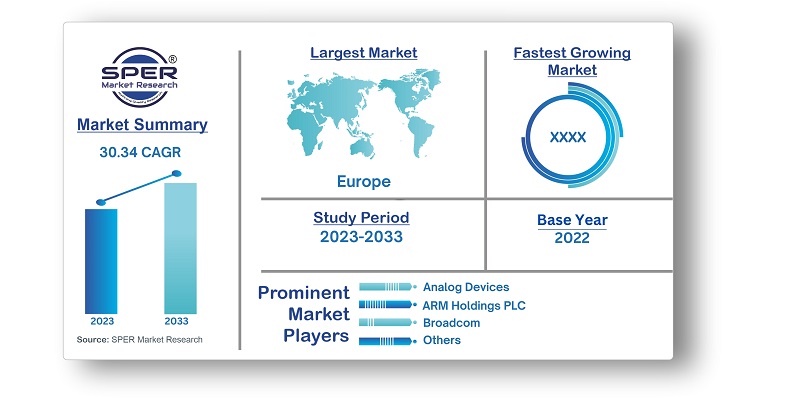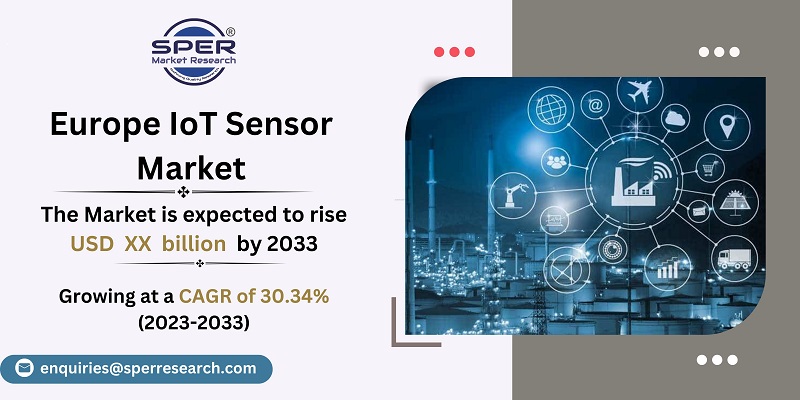
Europe IoT Sensor Market Growth, Size, Trends, Demand, Revenue, Share and Future Competition
Europe IoT Sensor Market Size- By Type, By Connectivity Type, By Application- Regional Outlook, Competitive Strategies and Segment Forecast to 2033
| Published: Feb-2024 | Report ID: SEMI2406 | Pages: 1 - 152 | Formats*: |
| Category : Semiconductor and Electronics | |||
- September 2021: The Dutch construction company Heijman has installed about 20,000 LORAWAN smart building IoT sensors for its clients through its subsidiary Beyond Eyes. By utilizing real-time insights about energy and water consumption, light intensity, humidity levels, carbon emissions levels, and noise levels, as well as by offering residents smart home features, the goal is to improve building management.


| Report Metric | Details |
| Market size available for years | 2019-2033 |
| Base year considered | 2022 |
| Forecast period | 2023-2033 |
| Segments covered | By Type, By Connectivity Type, By Application |
| Regions covered | Germany, France, Russia, UK, Rest of Europe |
| Companies Covered | Analog Devices, Inc., ARM Holdings PLC, Broadcom, Inc., Honeywell International, Inc., Infineon Technologies AG, NXP Semiconductors N.V., Omron Corporation, Robert Bosch GmbH, STMicroelectronics N.V., Texas Instruments Incorporated, Others. |
- Government and Regulatory Bodies
- Industry Players and Manufacturers
- Technology Providers
- Research and Development Organizations
- Investors and Financial Institutions
- Smart City Initiatives
| By Type: |
|
| By Connectivity Type: |
|
| By Application: |
|
- Europe IoT Sensor Market Size (FY’2023-FY’2033)
- Overview of Europe IoT Sensor Market
- Segmentation of Europe IoT Sensor Market By Type (Temperature sensor, Light Sensor, Pressure Sensor, Chemical Sensor, Motion Sensor, Others)
- Segmentation of Europe IoT Sensor Market By Connectivity Type (Wired, Wireless)
- Segmentation of Europe IoT Sensor Market By Application (Consumer Electronics, Building Automation, Healthcare, Automotive, Industrial, Retail, Others)
- Expansion Analysis of Europe IoT Sensor Market
- Problems and Obstacles in Europe IoT Sensor Market
- Competitive Landscape in the Europe IoT Sensor Market
- Impact of COVID-19 and Demonetization on Europe IoT Sensor Market
- Details on Current Investment in Europe IoT Sensor Market
- Competitive Analysis of Europe IoT Sensor Market
- Prominent Players in the Europe IoT Sensor Market
- SWOT Analysis of Europe IoT Sensor Market
- Europe IoT Sensor Market Future Outlook and Projections (FY’2023-FY’2033)
- Recommendations from Analyst
1.1. Scope of the report1.2. Market segment analysis
2.1. Research data source2.1.1. Secondary Data2.1.2. Primary Data2.1.3. SPER’s internal database2.1.4. Premium insight from KOL’s2.2. Market size estimation2.2.1. Top-down and Bottom-up approach
2.3. Data triangulation
4.1. Driver, Restraint, Opportunity and Challenges analysis4.1.1. Drivers4.1.2. Restraints4.1.3. Opportunities4.1.4. Challenges4.2. COVID-19 Impacts of the Europe IoT Sensor Market
5.1. SWOT Analysis5.1.1. Strengths5.1.2. Weaknesses5.1.3. Opportunities5.1.4. Threats5.2. PESTEL Analysis5.2.1. Political Landscape5.2.2. Economic Landscape5.2.3. Social Landscape5.2.4. Technological Landscape5.2.5. Environmental Landscape5.2.6. Legal Landscape5.3. PORTER’s Five Forces5.3.1. Bargaining power of suppliers5.3.2. Bargaining power of buyers5.3.3. Threat of Substitute5.3.4. Threat of new entrant5.3.5. Competitive rivalry5.4. Heat Map Analysis
6.1. Europe IoT Sensor Market Manufacturing Base Distribution, Sales Area, Product Type6.2. Mergers & Acquisitions, Partnerships, Product Launch, and Collaboration in Europe IoT Sensor Market
7.1. Europe IoT Sensor Market Value Share and Forecast, By Type, 2023-20337.2. Temperature sensor7.3. Light Sensor7.4. Pressure Sensor7.5. Chemical Sensor7.6. Motion Sensor7.7. Others
8.1. Europe IoT Sensor Market Value Share and Forecast, By Connectivity Type, 2023-20338.2. Wired8.3. Wireless
9.1. Europe IoT Sensor Market Value Share and Forecast, By Application, 2023-20339.2. Consumer Electronics9.3. Building Automation9.4. Healthcare9.5. Automotive9.6. Industrial9.7. Retail9.8. Others
10.1. Europe IoT Sensor Market Size and Market Share
11.1. Europe IoT Sensor Market Size and Market Share By Type (2019-2026)11.2. Europe IoT Sensor Market Size and Market Share By Type (2027-2033)
12.1. Europe IoT Sensor Market Size and Market Share By Connectivity Type (2019-2026)12.2. Europe IoT Sensor Market Size and Market Share By Connectivity Type (2027-2033)
13.1. Europe IoT Sensor Market Size and Market Share By Application (2019-2026)13.2. Europe IoT Sensor Market Size and Market Share By Application (2027-2033)
14.1. Europe IoT Sensor Market Size and Market Share By Region (2019-2026)14.2. Europe IoT Sensor Market Size and Market Share By Region (2027-2033)14.3. France14.4. Germany14.5. Russia14.6. UK14.7. Rest of Europe
15.1. Analog Devices, Inc.15.1.1. Company details15.1.2. Financial outlook15.1.3. Product summary15.1.4. Recent developments15.2. ARM Holdings PLC15.2.1. Company details15.2.2. Financial outlook15.2.3. Product summary15.2.4. Recent developments15.3. Broadcom, Inc.15.3.1. Company details15.3.2. Financial outlook15.3.3. Product summary15.3.4. Recent developments15.4. Honeywell International, Inc.15.4.1. Company details15.4.2. Financial outlook15.4.3. Product summary15.4.4. Recent developments15.5. Infineon Technologies AG15.5.1. Company details15.5.2. Financial outlook15.5.3. Product summary15.5.4. Recent developments15.6. NXP Semiconductors N.V.15.6.1. Company details15.6.2. Financial outlook15.6.3. Product summary15.6.4. Recent developments15.7. Omron Corporation15.7.1. Company details15.7.2. Financial outlook15.7.3. Product summary15.7.4. Recent developments15.8. Robert Bosch Gmbh15.8.1. Company details15.8.2. Financial outlook15.8.3. Product summary15.8.4. Recent developments15.9. STMicroelectronics N.V.15.9.1. Company details15.9.2. Financial outlook15.9.3. Product summary15.9.4. Recent developments15.10. Texas Instruments Incorporated15.10.1. Company details15.10.2. Financial outlook15.10.3. Product summary15.10.4. Recent developments15.11. Others
SPER Market Research’s methodology uses great emphasis on primary research to ensure that the market intelligence insights are up to date, reliable and accurate. Primary interviews are done with players involved in each phase of a supply chain to analyze the market forecasting. The secondary research method is used to help you fully understand how the future markets and the spending patterns look likes.
The report is based on in-depth qualitative and quantitative analysis of the Product Market. The quantitative analysis involves the application of various projection and sampling techniques. The qualitative analysis involves primary interviews, surveys, and vendor briefings. The data gathered as a result of these processes are validated through experts opinion. Our research methodology entails an ideal mixture of primary and secondary initiatives.



Frequently Asked Questions About This Report
PLACE AN ORDER
Year End Discount
Sample Report
Pre-Purchase Inquiry
NEED CUSTOMIZATION?
Request CustomizationCALL OR EMAIL US
100% Secure Payment






Related Reports
Our Global Clients
Our data-driven insights have influenced the strategy of 200+ reputed companies across the globe.




















